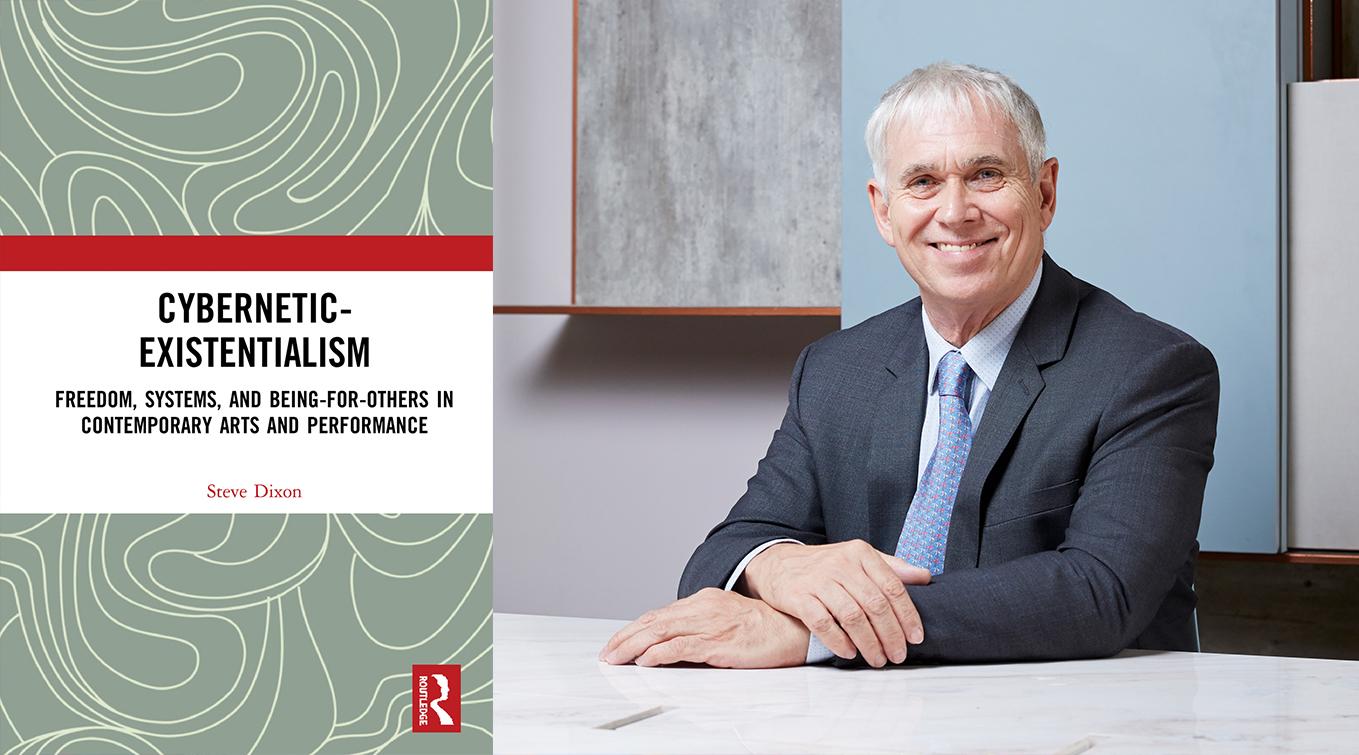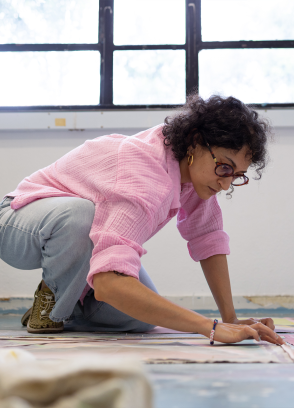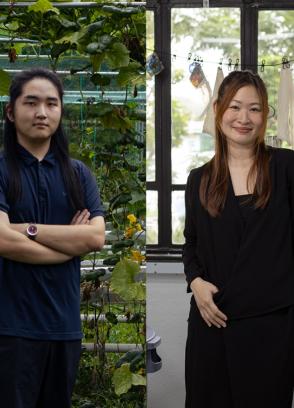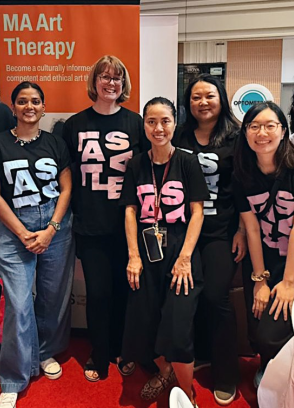Cybernetic-Existentialism: Q&A with Professor Steve Dixon
What do Damien Hirst, Ai Weiwei, Walter White from Breaking Bad and Frozen’s Princess Elsa have in common? In his radical new book Cybernetic-Existentialism: Freedom, Systems, and Being-for-Others in Contemporary Arts and Performance (Routledge 2020), LASALLE President Professor Steve Dixon brings together contemporary art, popular culture and pressing socio-political issues to reveal surprising threads of commonality.
A five-year labour of love, Cybernetic-Existentialism interrogates increasingly timely themes of authenticity, angst and alienation, and the convergence of humans and machines. Over 50 case studies vividly illustrate how existentialist ideas combine with cybernetic concepts, providing a novel lens through which to view contemporary art.
We sat down with Steve for a conversation on the inspiration behind the book, moments of synchronicity as well as how LASALLE continues to evolve as a contemporary art institution.
Hi Steve, congratulations on the publication of your book! Could you share a bit about your initial inspiration?
My wife Prue and I went to the Kochi-Muziris Biennale in India in 2015. One piece in particular struck me—Anish Kapoor’s Descension—a perpetually swirling whirlpool of very black water disappearing into a central vortex like a giant plughole.
I was reminded of Jean-Paul Sartre’s Being and Nothingness, in which he suggests that the ‘absence’ and void of nothingness are as important for people to confront, and even celebrate, as the ‘presence’ of life. These themes, combined with Kapoor’s motorised cybernetic technological system, inspired me to reread existentialist philosophy (I’d been interested in it as a student) and some classic books on cybernetics.
Every time I visited a gallery exhibition, it seemed that I was seeing more and more examples of artworks that combined ideas and practices central to the two fields. Researchers know that this sometimes happens when you immerse yourself in a subject—it seems to pop up everywhere—but it was quite uncanny how many examples there were, some directly quoting existentialist texts.
Yes, these moments of synchronicity can sometimes end up having a major impact on artistic projects. What was one such moment for you?
In January 2015, Turner Prize-winning artists Gilbert & George gave a public lecture at LASALLE to a packed audience of 500. They insisted that their art and their lives were the same thing. They told students they should forge unique identities and make up their own rules since the only purpose of life is to be authentic, create meaning and try to change things. Chatting to them post-lecture, I noted that the existentialists had said very similar things. Gilbert & George recalled how as students in the 1960s they had been interested in the philosophy and hadn’t given it much thought since, but should perhaps look at it once again.
10 months later it appeared they had, when during an interview in the UK newspaper The Telegraph they announced: “More and more, I think we’re existentialists.” They became the major case study in one of my chapters on the subject of the changing nature of identity in both society and the art world.
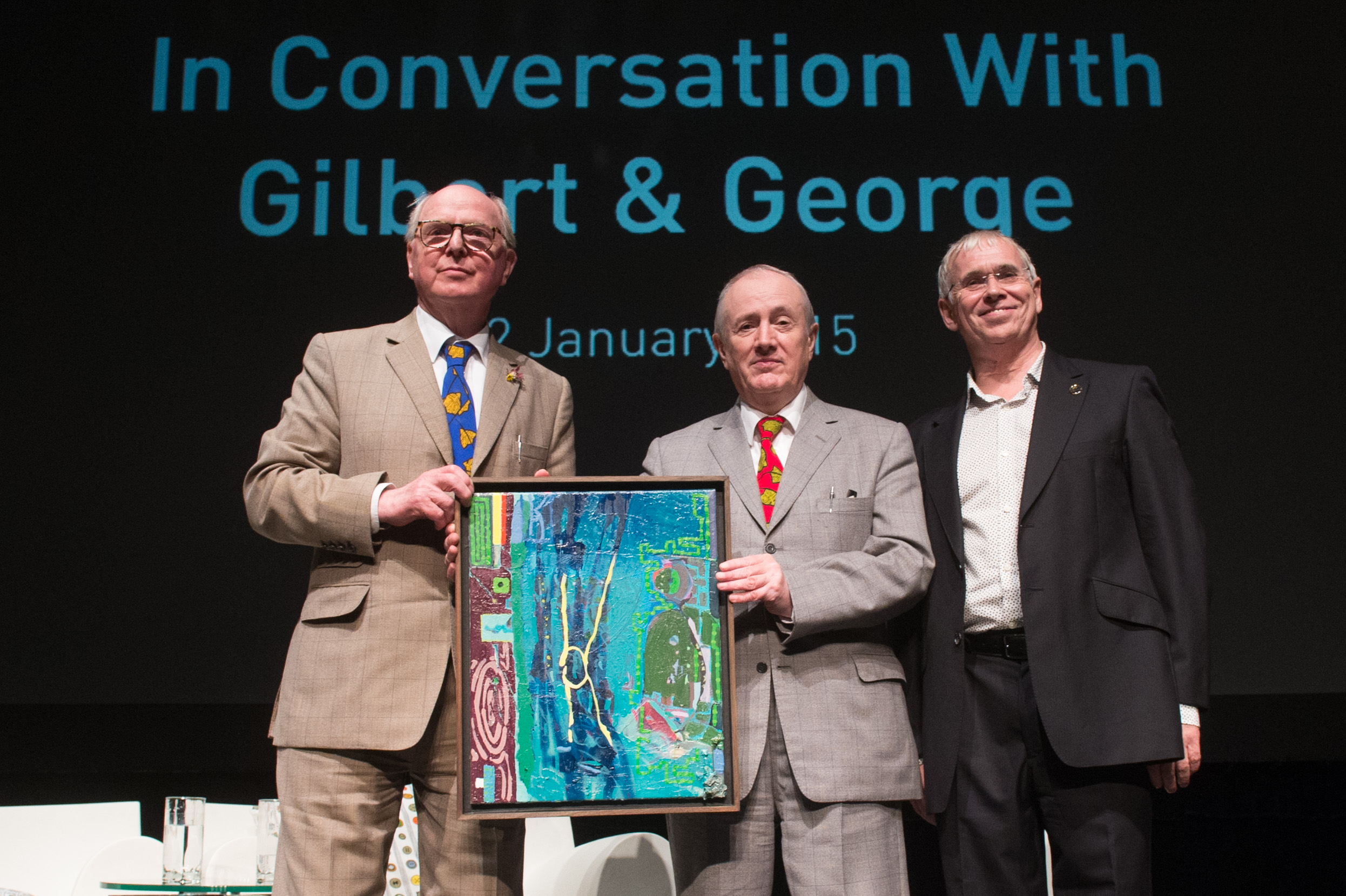 “More and more I think we’re existentialists”. Gilbert and George, pictured with Professor Steve Dixon (right) at a public lecture at LASALLE College of the Arts.
“More and more I think we’re existentialists”. Gilbert and George, pictured with Professor Steve Dixon (right) at a public lecture at LASALLE College of the Arts.
You’ve said that you feel both ideas, cybernetics and existentialism – which first emerged in the 1950s and 1960s – are more relevant now than ever before. Why is that?
Because I think things have come full circle. We’re more technologically advanced now, of course, and that’s in many ways ‘thanks’ to the innovations of cybernetics, which directly paved the way for the first moon landing and the Internet. But equally nowadays, the power of these systems is becoming perceived as problematic. Like the 1940s, I think we’re in an era facing a similar ‘existential crisis’ and an increasing sense of anxiety and fear of death. Back then it was framed by the horrific consequences of World War II. Today, parallel anxieties intensify over issues ranging from a global warming crisis and fundamentalism, to the types of politics of intolerance and the extreme that ultimately led to World War II.
But there are also hugely positive aspects to both fields that are finding greater relevance today. Interactive cybernetic technologies and AI are creating new breakthroughs in science and the arts. In the book, I discuss robots performing alongside humans in theatre productions, and audiences and artists being brought together from different countries using virtual reality (VR) environments. One chapter explores how art has now not only entered the realm of science fiction, but is ‘actualising’ the predictions of sci-fi, with artists such as Stelarc technologically modifying his body to become an actual cyborg.
We also see existentialism’s messages to continually ‘re-create’ (rather than ‘find’) yourself, and to live life authentically and to the full, being reinforced continually not only by artists, but also within popular culture—think of retail slogans like Nike’s ‘Just Do It’. There’s now a resurgence of interest in both fields, with books such as Sarah Bakewell’s At the Existentialist Café appearing as one the New York Times Top Ten books of 2016. My book is a part of what seems a growing revival.
What was something surprising or unexpected you found in your research?
For me, it was the discovery that almost all of the world’s richest and most successful artists including Jeff Koons, Ai Weiwei, and Damien Hirst, are ones that I would describe as ‘cybernetic-existentialists’. Whether consciously or unconsciously, they all make extensive use of cybernetic principles and existentialist philosophical beliefs.
Surprising too was how these themes are appearing more and more within popular culture. The central characters of Breaking Bad and Frozen, Walter White and Elsa, are classic existentialist ‘outsiders’: anti-heroes/heroines who seek to challenge authority and live life to the extreme, while using cybernetic processes to further their ambitions.
These were not simply ‘successful’ media products. They hit a note that caught the popular imagination to become huge cultural phenomena. They encapsulated a contemporary zeitgeist concerned with self-creation, freedom, authenticity and making synthesising connections between humans and their environment—what I am defining as Cybernetic-Existentialism.
The contexts and lenses through which we experience contemporary art are changing all the time, as exemplified by your own research. How do you envision LASALLE continuing to evolve as a contemporary art institution?
Contemporary art has always pursued the big questions, like those posed in the mid-20th century by the philosophers and scientists I’ve researched. But more and more, I see contemporary art moving toward more direct expressions of, and responses to these questions, and also looking to connect more directly and personally with their audiences.
This is very evident in our students’ work at LASALLE, and the research interests, themes, and concerns that are increasingly emerging in their artistic practices. Artists are exploring identity issues far more than they ever were, and engaging in deep and existentially meaningful exchanges with strangers. We are also seeing work that addresses social, political and ecological issues with renewed intensity and purpose.
LASALLE has always sought to develop new artistic ideas and techniques, to use the potential of emerging technologies to the full, and to be at the forefront of contemporary debates in arts research. Our faculty and students, particularly the Media Lab, have done some hugely innovative work with cybernetic systems in Singapore – from interactive gallery installations to online environments. Through this, we seek to make brave artistic statements that are existential in nature—about what it means to be alive, and how it’s possible to make a difference in today’s world.
Our students and staff never fail to surprise me with their startling ideas and creative advances. We will continue to push the envelope in both our research activities and our artistic practices.

